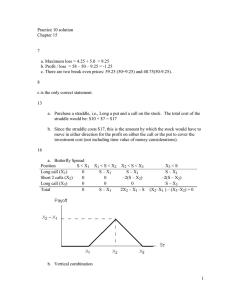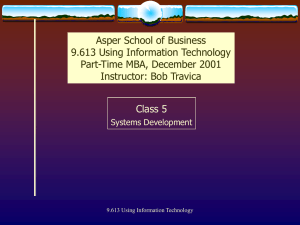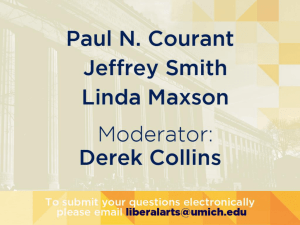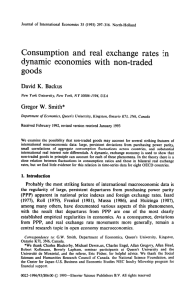ENDOGENOUS TRADE POLICIES IN A DEVELOPING ECONOMY B N
advertisement
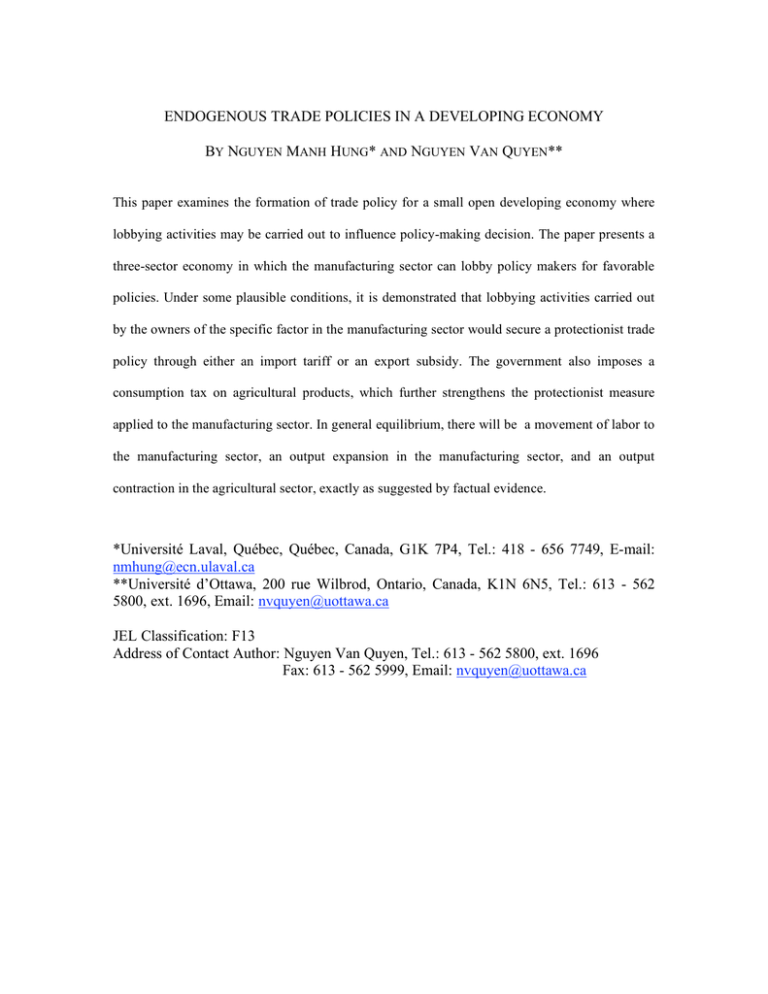
ENDOGENOUS TRADE POLICIES IN A DEVELOPING ECONOMY BY NGUYEN MANH HUNG* AND NGUYEN VAN QUYEN** This paper examines the formation of trade policy for a small open developing economy where lobbying activities may be carried out to influence policy-making decision. The paper presents a three-sector economy in which the manufacturing sector can lobby policy makers for favorable policies. Under some plausible conditions, it is demonstrated that lobbying activities carried out by the owners of the specific factor in the manufacturing sector would secure a protectionist trade policy through either an import tariff or an export subsidy. The government also imposes a consumption tax on agricultural products, which further strengthens the protectionist measure applied to the manufacturing sector. In general equilibrium, there will be a movement of labor to the manufacturing sector, an output expansion in the manufacturing sector, and an output contraction in the agricultural sector, exactly as suggested by factual evidence. *Université Laval, Québec, Québec, Canada, G1K 7P4, Tel.: 418 - 656 7749, E-mail: nmhung@ecn.ulaval.ca **Université d’Ottawa, 200 rue Wilbrod, Ontario, Canada, K1N 6N5, Tel.: 613 - 562 5800, ext. 1696, Email: nvquyen@uottawa.ca JEL Classification: F13 Address of Contact Author: Nguyen Van Quyen, Tel.: 613 - 562 5800, ext. 1696 Fax: 613 - 562 5999, Email: nvquyen@uottawa.ca 1. Introduction According to the “new political economy,” trade protection is endogenous in the sense that it results from motives lying outside the realm of pure economic efficiency. To achieve political goals, governments often carry out policies that distort trade flows and affect the distribution of income. These distorting trade policies could be explained through the political-support function of Hillman (1982), Long and Vousden (1991); the electoral competition approach of Brock and Magee (1978); the factor-ownership distribution cum voter participation costs under majority voting of Mayer (1984); or the more recent influence-buying approach of Grossman and Helpman (1994, GH hereafter), who applied the theoretical machinery of a first-price menu auction developed by Bernheim and Whinston (1986, BW hereafter). According to Watkins and von Braun (2003), high tariffs and trade barriers are used by industrialized nations to keep out imports, and each year the rich countries spend US$300 billion to support their agriculture. This leaves billions of people in the developing world with no market to export their agricultural products. Ironically, the response of poor nations to Western protectionism is also to adopt protectionist measures, but in the manufacturing sector – deemed to consist of all infant industries. In this paper, we attempt to analyze the consequences of influence buying in a small developing country that is opened for international trade. There are three production sectors: a sector producing a freely traded good, a sector producing a traded manufacturing good, and a sector producing a non-traded good (the agricultural sector). Following Samuelson (1971) and Jones (1971), we assume that the production technology in these sectors requires the use of labor and a specific factor. The production 2 structure in our model is the same as that of Corden and Neary (1982, CN hereafter), who drew on Jones, op cit., in formulating a model for analyzing the problem of booming and declining sectors in a small open economy. Most of comparative static generalequilibrium results used in our paper can be found in CN. However, in our paper, we go further than CN and offer an explanation for the endogenous determination of policies driven by lobbying activities. In our model, owners of the specific factor in the production of the traded good is highly concentrated, which makes it easier for them to get organized as a special-interest group to lobby policy makers for the adoption of favorable trade policies. In contrast, small farmers in the non-traded good sector are widely dispersed and thus are not able to organize themselves to influence policy makers. Workers could not exert such influence, either, because there is effectively no institution, such as labor unions, that might play a role in setting wages. Thus in exchange for their labor, workers receive a competitive wage determined by market conditions. We would like to point out at this point that the wage rate is endogenously determined in our analysis, not fixed as in the framework of GH. Trade policies, therefore, have an impact on the supply side through intersectoral allocation – in contrast with the analysis of GH, who considered only the repercussions on the demand side. Under some plausible conditions, we are able to show that lobbying activities carried out by the owners of the specific factor in the manufacturing sector secure a protectionist trade policy through either an import tariff or an export subsidy for this sector. Also, the owners of the specific factor in agriculture in our model will have to bear a tax. Thus, the owners of the specific factor in the manufacturing sector also benefit indirectly from the consumption tax imposed on the consumption of the non-traded good. 3 Labor moves to the manufacturing sector, and at the new equilibrium there will be an output expansion in this sector and an output contraction in the agricultural sector. The rent made by the owners of the specific factor in the manufacturing sector will rise after the new equilibrium has been established, while the rent obtained by the owners of the specific factor in the agricultural sector may rise or fall, depending on the parameters of the model. The paper is organized as follows. In Section 2, we present our model – a three-stage game in which we allow for labor mobility across the three sectors of production. Within a general-equilibrium setting, we solve our problem of endogenous policy formation in Section 3. Finally, in Section 4, we discuss several possible extensions of the model. 2. The Model Consider a small open economy in which three goods – labeled good 1, good 2, and good 3 – are produced from labor and capital. Goods 1 and 2 are traded on world markets, while good 3 is non-traded. For a developing country, good 3 may either be a nonexportable local service or an agricultural product, which are heavily protected by their industrialized trading partners. Good 1 is freely traded, and is chosen as the numéraire. The world prices of goods 1 and 2 are denoted, respectively, by p10 and p20 . The domestic prices of good i faced by its producers and consumers are denoted by pi and qi , respectively. For good 2, the government can impose an import tariff (or an export subsidy) " 2 ! 0 . In this case, p2 = q2 = p20 + ! 2 . For good 3, the non-traded good, we shall assume that a consumption tax (subsidy), ! 3 ! 0 (! 3 ! 0 ), is imposed on its consumers. In this case, q3 = p3 + ! 3 . A combination (! 2 ,! 3 ) will be referred to as a policy. 4 On the production side, labor is assumed to be homogenous and perfectly mobile. Its fixed supply is denoted by L . Capital is sector-specific, and the capital stock in sector i is denoted by Ki , i = 1,2,3. The output of good i is given by Yi = Fi ( Li , K i ) , where Li is the labor input and Fi is a standard neoclassical production function that exhibits constant returns to scale. The rent accruing to the sector-specific capital is then given by piYi " !Li , where ! is the prevailing wage rate. Sector i solves the following rent maximization problem: (1) max Li pi Fi ( Li , K i ) " #Li = ! i ( pi , # ), for i = 1,2,3. We shall let Li ( pi , ! ) denote the labor input used by sector i and Yi ( pi , ! ) = Fi (Li ( pi , ! ), Ki ) denote this sector’s output. The population of the small open economy is assumed to be a continuum of measure 1. Each individual in the population owns only one type of input. We refer to group i as the group of individuals who own the specific factor K i . For each i = 1,2,3, let ! i denote the size of group i relative to the total population. The workers – as a group – will be referred to as group 4. If L < ! 4 , then " 4 ! L represents the number of individuals who are either unemployed or working in the informal sector. Although this feature is common in a developing economy, it is not the subject of our analysis. Thus we assume that L = ! 4 . This assumption implies that groups 1, 2, and 3 obtain their incomes through the ownership of sector-specific capital, while group 4 obtains its income by selling its labor. We expect that ! 4 is large relative to ! i , i = 1,2,3. A group, such as the owners of a specific input, who see their income tied to the price of the output that this specific input helps to produce, have an incentive to lobby policy 5 makers for policies that enhance their income. In many developing economies, the owners of the specific input used in infant manufacturing industries often become organized to lobby the government for favorable policies. In this paper, we concentrate on this problem – with group 2 as the focus of our attention. Individual preferences are identical and represented by the following quasi-linear utility 3 function: ( x1 , x2 , x3 ) " x1 + !i = 2 ui ( xi ), where xi is the consumption of good i and ui is the sub-utility function associated with the consumption of good i, i = 2,3. The sub-utility function ui is assumed to be continuously differentiable, strictly increasing, and strictly concave. An individual with an income m at his disposal solves the following utility maximization problem: 3 3 max (x2 , x3 ) m " ! qi xi + ! ui ( xi ) i =2 (2) i =2 3 subject to m " #i =2 qi xi ! 0. Assuming that this problem has an interior solution, the following first-order condition characterizes the demand for good i, i = 2,3 : ui ' ( xi ) ! qi = 0. (3) We shall let xi ( qi ) denote the value of xi that solves (3). The indirect utility function of an individual is then given by v ( q1 , q2 , m ) = m + s( q1 , q2 ), (4) where 3 s( q2 , q3 ) = ! [ui (xi ( qi ) )" qi xi ( qi )] (5) i =2 is the consumer surplus enjoyed by this individual. 6 The game of endogenous policy formation has three stages and its extensive form is as follows. In the first stage, group 2 lobbies the government by communicating to the policy makers a contingent payment schedule C2 : (! 2 ,! 3 ) " C2 (! 2 ,! 3 ), where C2 (! 2 ,! 3 ) represents the payment that it is willing to make to the government if the policy (! 2 ,! 3 ) is implemented. The payment C2 (! 2 ,! 3 ) – also called the political contribution in the literature – is expressed in terms of the numéraire, and is valued by policy makers because it can be used to finance future elections or simply put away for personal use. In the second stage of the game, the policy makers take as given the contingent payment schedule C2 and implement a policy according to some criterion which depends on the payment as well as on some measure of social welfare. In the third stage of the game, the producers take as given the policy implemented by the policy makers in the second stage and carry out their production plans to maximize profit. As for consumers, they make their consumption decisions, which depend on their incomes as well as the prices they face. Group 2 will then make the payment it promised the government in the first stage. Suppose that (! 2 ,! 3 ) is the policy implemented by the policy makers in the second stage. The general equilibrium of the small open economy is characterized by the following market-clearing conditions: L1 (1, " ) + L2 ( p20 + # 2 , " ) + L3 ( p3 , " ) = ! 4 , (6) x3 ( p3 + " 3 ) = Y3 ( p3 , ! ). (7) Together, (6) and (7) constitute a system of two equations in the two unknowns p3 and !. We shall denote by p3 (! 2 ,! 3 ) and " (! 2 ,! 3 ) the equilibrium price of the non-traded good and the equilibrium wage rate that are induced by the policy (! 2 ,! 3 ). 7 The tax revenue collected under the policy (! 2 ,! 3 ) is [ ] T (! 2 ,! 3 ) = ! 2 x2 ( p20 + ! 2 ) # Y2 (p20 + ! 2 , " (! 2 ,! 3 ) ) + ! 3 x3 (p3 (! 2 ,! 3 ) + ! 3 ). (8) We shall assume that the tax revenue collected by the government is redistributed equally to all the individuals in the economy. Under the policy (! 2 ,! 3 ), the payoff of group 1 is given by [ ] W1 (! 2 ,! 3 ) = $1 (1, # (! 2 ,! 3 ) )+ " 1 T (! 2 ,! 3 ) + s (p20 + ! 2 , p3 (! 2 ,! 3 ) + ! 3 ). (9) The gross payoff of group 2 – before the political contributions are made – is given by [ ] W2 (! 2 ,! 3 ) = $ 2 (p20 + ! 2 , # (! 2 ,! 3 ) )+ " 2 T (! 2 ,! 3 ) + s (p20 + ! 2 , p3 (! 2 ,! 3 ) + ! 3 ), (10) and its net payoff by W2 (! 2 ,! 3 ) " C2 (! 2 ,! 3 ). As for group 3 and group 4, their payoffs are given, respectively, by [ ] W3 (! 2 ,! 3 ) = $ 3 (p3 (! 2 ,! 3 ), # (! 2 ,! 3 ) )+ " 3 T (! 2 ,! 3 ) + s (p20 + ! 2 , p3 (! 2 ,! 3 ) + ! 3 ), (11) and [ ] W4 (! 2 ,! 3 ) = # 4 " (! 2 ,! 3 ) + T (! 2 ,! 3 ) + s (p20 + ! 2 , p3 (! 2 ,! 3 ) + ! 3 ). (12) The gross social welfare – before the political contributions are made – is then given by W (! 2 ,! 3 ) = $1 (1, " (! 2 ,! 3 ) )+ $ 2 (p20 + ! 2 , " (! 2 ,! 3 ) )+ $ 3 (p3 (! 2 ,! 3 ), " (! 2 ,! 3 ) ) + # 4" (! 2 ,! 3 ) + T (! 2 ,! 3 ) + s (p20 + ! 2 , p3 (! 2 ,! 3 ) + ! 3 ), (13) and the net social welfare – as a function of the contingent political contribution schedule C2 and the policy (! 2 ,! 3 ) is then given by W (! 2 ,! 3 ) " C2 (! 2 ,! 3 ). The payoff of the government is assumed to be given by $(! 2 ,! 3 , C2 ) = "C2 (! 2 ,! 3 ) + W (! 2 ,! 3 ) # C2 (! 2 ,! 3 ) = (" # 1)C2 (! 2 ,! 3 ) + W (! 2 ,! 3 ). (14) 8 In (14), ! represents the weight assigned to the political component of payoff. Note that in the payoff function, net social welfare receives a weight equal to 1. In order for the government to accept political contribution, it is necessary that ! > 1. If " ! 1, a transfer from any group to the government will decrease the latter player’s payoff. Now let #(C2 ) = arg max (! 2 ,! 3 ) "(! 2 ,! 3 , C2 ). (15) As defined, !(C2 ) is the set of policies that are best against C2 . Definition: Let C2* : (! 2 ,! 3 ) " C2* (! 2 ,! 3 ) be a feasible contingent payment schedule and (! * 2 ,! 3* ) a policy. We say that the list (C2* ,! 2* ,! 3* ) is a Nash equilibrium for the game of endogenous policy formation if the following conditions are satisfied. First, (# 2* ,# 3* ) " !(C2* ). Second, for any feasible contingent payment schedule C2 of group 2, we have W2 (! 2* ,! 3* ) " C2* (! 2* ,! 3* ) # sup(! 2 ,! 3 )%$( C 2 ) [W2 (! 2 ,! 3 ) " C2 (! 2 ,! 3 )]. 3. The Endogenous Determination of Policies Let " (! 2 ,! 3 ) be the equilibrium wage rate that prevails in the small open economy, when (! 2 ,! 3 ) is the policy implemented by policy makers. Welfare Maximization If policy makers’ objective is to maximize social welfare, then the government solves the following maximization problem: max (! 2 ,! 3 ) W (! 2 ,! 3 ) = µ0 . (16) The following first-order conditions characterize the solution of (16): D1W (! 2 ,! 3 ) = [ D1Zˆ 2 (! 2 ,! 3 )]! 2 + [ D1Yˆ3 (! 2 ,! 3 )]! 3 = 0, (17) 9 D2W (! 2 , ! 3 ) = [ D2 Zˆ 2 (! 2 , ! 3 )]! 2 + [ D2Yˆ3 (! 2 , ! 3 )]! 3 = 0, (18) where we have let Zˆ 2 (! 2 ,! 3 ) = x2 ( p20 + ! 2 ) # Y2 ( p20 + ! 2 , " (! 2 ,! 3 )) and Yˆ3 (! 2 ,! 3 ) = Y3 ( p3 (! 2 ,! 3 ), " (! 2 ,! 3 )) denote, respectively, the equilibrium level of the import of good 2 and the equilibrium output of the non-traded good under the policy (! 2 ,! 3 ). Now define #(! 2 ,! 3 ) = [ D1Zˆ 2 (! 2 ,! 3 )][ D2Yˆ3 (! 2 ,! 3 )] " [ D2 Zˆ 2 (! 2 ,! 3 )][ D1Yˆ3 (! 2 ,! 3 )]. Next, note that as ! 2 rises, the demand for good 2 declines, but its supply goes up. Hence D1Zˆ 2 (! 2 ,! 3 ) < 0. Also, we have D1Yˆ3 (! 2 ,! 3 ) < 0. Also, note that when ! 3 rises the output of good 2 goes up, but the output of good 3 goes down. Furthermore, a rise in ! 3 alone does not affect the demand for good 2. Hence D2 Zˆ 2 (! 2 ,! 3 ) < 0 and D2Yˆ3 (! 2 , ! 3 ) < 0. Without further restrictions, we cannot determine the sign of "(! 2 ,! 3 ) unambiguously. If we let "2,i (! 2 ,! 2 ) and "3,i (! 2 ,! 2 ) denote, respectively, the elasticity of Zˆ 2 (! 2 ,! 3 ) and the elasticity of Yˆ3 (! 2 ,! 3 ) with respect to ! i , then "(! 2 ,! 3 ) can be rewritten as follows: & * () , ) )* () , ) ) # (() 2 , ) 3 ) = [ D1 Zˆ 2 () 2 , ) 3 )][ D2Yˆ3 () 2 , ) 3 )]$1 ' 2,3 2 3 3, 2 2 3 !. % * 2, 2 () 2 , ) 3 )*3,3 () 2 , ) 3 ) " Intuitively, we expect that the own-price effect dominates the cross-price effect, i.e., " 2,3 (! 2 , ! 3 ) / " 2, 2 (! 2 , ! 3 ) < 1 , "3, 2 (! 2 , ! 3 ) / "3,3 (! 2 , ! 3 ) < 1. (19) Thus if both inequalities in (19) hold, then !(" 2 ," 3 ) > 0. In this case, the only values of ! 2 and ! 3 that satisfy the system constituted by (17) and (18) are ! 2 = ! 3 = 0; that is, the policy that maximizes social welfare is that of non-intervention. 10 Determination of Endogenous Policy If (! 2 ,! 3 ) is a policy that group 2 wishes the government to implements, then the shortfall in the social welfare component of the government’s payoff is µ0 " W (! 2 ,! 3 ). To induce the government into implementing this policy, group 2 must promise a payment of at least (µ0 ! W (# 2 ,# 3 ) )/(" ! 1). The net payoff of group 2 – after the payment has been made – is then equal to W2 (# 2 , # 3 ) ! (µ 0 ! W (# 2 , # 3 ) )/(" ! 1). Hence the policy that the owners of the specific input used in the production of good 2 would like policy makers to implement is the solution of the following maximization problem : µ ) W (" 2 ," 3 ) % ( max (" 2 ," 3 ) &W2 (" 2 ," 3 ) ) 0 #$ = µ2 . ! )1 ' (20) The following first-order conditions characterize the solution of (20) [ D1Zˆ 2 (! 2 ,! 3 )]! 2 + [ D1Yˆ3 (! 2 ,! 3 )]! 3 = "ˆD1W2 (! 2 ,! 3 ), (21) [ D2 Zˆ 2 (! 2 ,! 3 )]! 2 + [ D2Yˆ3 (! 2 ,! 3 )]! 3 = "ˆD2W2 (! 2 ,! 3 ). (22) Note that in (21) and (22), we have used (17) and (18) as well as let "ˆ = 1 ! " < 0. The policy, say (! 2* ,! 3* ), that solves the system constituted by (21) and (22) satisfies the following conditions: ) 2* = & + 2,3 () 2* , ) 3* )*3, 2 () 2* , ) 3* ) # ,ˆ ˆ D W ( ) , ) ) D Y ( ) , ) ) 1 2 2 3 2 3 2 3 $1 ' * * * * ! ( () 2* , ) 3* ) % + 2, 2 () 2 , ) 3 )*3, 2 () 2 , ) 3 ) " (23) and & + 2, 2 () 2* , ) 3* )* 2,3 () 2* , ) 3* ) # ,ˆ * * * * ˆ ) = D2W2 () 2 , ) 3 ) D1 Z 2 () 2 , ) 3 ) $1 ' . * * * * ! ( () 2* , ) 3* ) % + 2,3 () 2 , ) 3 )* 2, 2 () 2 , ) 3 ) " * 3 (24) 11 In (23) and (24), "i , j (! 1 ,! 2 ), i, j = 2,3, are the elasticities already defined, while " 2, j (! 1 ,! 2 ), j = 2,3, is the elasticity of W2 (! 2 ,! 3 ) with respect to ! j , j = 2,3. In the same manner that we expect the inequalities in (19) to hold, we should also expect that for the gross payoff of group 2, the own-price elasticity will dominate the cross-price elasticity, i.e., " 2,3 (! 2 ,! 3 ) < " 2, 2 (! 2 ,! 3 ). (25) Hence when (25) and both inequalities in (19) hold, the expressions inside the square brackets in (23) and (24) will both be positive. Next, recall that when both inequalities in (19) hold, ! (" 2* , " 3* )> 0. Also, recall that D2Yˆ3 (! 2* ,! 3* ) < 0. Thus, ! 2* will be positive or negative depending on whether D1W2 (! 2* ,! 3* ) is positive or negative. Now W2 (! 2 ,! 3 ), the gross payoff of group 2, has three components: rent, government transfer, and consumer surplus. The rent component increases when ! 2 rises. A rise in ! 2 causes the consumer surplus associated with the consumption of this good to decline. Also, a rise in ! 2 will induce a rise in the consumer price of the non-traded good, causing the consumer surplus associated with the consumption of this good to decline. As for the government transfer component, if good 2 is exported, a rise in ! 2 means an increase in the subsidy given to the export of this commodity, resulting in a heavier tax burden on each individual of the small open economy. If good 2 is imported, a rise in ! 2 raises the tariff revenues collected on the imports of this commodity. Furthermore, if the tax on the consumption of the non-traded good is positive, the decline in its production – induced by a rise in ! 2 – will lead to a lower level of tax revenues collected from this sector. On the other hand, if the consumption of the non-traded good is subsidized, then a rise in ! 2 will 12 reduce the subsidy given to the consumption of this good. The overall impact of a rise in ! 2 on the payoff of group 2 depends on the net effects of these conflicting movements. However, when the ownership of the specific input in sector 2 is highly concentrated, i.e., when ! 2 is very small, we can ignore the government transfer and the consumer surplus components in the gross payoff for good 2. In this case, the gross payoff of group 2 can be approximated by the rents accruing to the specific input in this sector, and we have D1W2 (! 2* ,! 3* ) > 0. We have just shown that if the ownership of the specific input in sector 2 is highly concentrated and if the own-price effects dominate the cross-price effects, then the owners of the specific input in sector 2 will be able to lobby policy makers either for a tariff or an export subsidy for good 2. As for ! 3* , in general, its sign depends on the sign of D2W2 (! 2* ,! 3* ). A rise in the tax on the consumption of the non-traded good depresses the wage rate and causes the producer price of the non-traded good to fall. Both sectors 1 and 2 expand at the expense of sector 3. For the owners of the specific input in sector 2, they see the rent they obtain rise with ! 3 . The consumer surplus that they obtain from the consumption of good 2 also rises. As in the analysis on the sign of ! 2* , if the ownership of the specific input in sector 2 is highly concentrated, then we have D2W2 (! 2* ,! 3* ) > 0, which leads to ! 3* > 0. We have proved the following proposition, which is the central result of the paper: Proposition: Suppose that the inequalities in (19) and the inequality in (25) hold, i.e., the own-price effects dominate the cross-price effects. If the ownership of the specific input in sector 2 is highly concentrated, then through its lobbying activities, group 2 will manage to obtain support for its industry, either through an import tariff or an export 13 subsidy. Furthermore, its lobbying activities will induce the government to impose a tax on the consumption of the non-traded good. Also, the lobbying activities of group 2 result in an expansion of sector 2 and a contraction of sector 3. As for sector 1, it is not clear whether it expands or contracts. Proof: The first two statements of the proposition have been established. To establish the last two, let us imagine that starting from the initial state of non-intervention, policy makers implement first the policy ! 2* , then the policy ! 3* . First, note that when ! 2 rises from 0 to ! 2* , sector 2 expands, but sectors 1 and 3 contract. The equilibrium wage rate that results from this part of the policy move is higher than the equilibrium wage rate under nonintervention. Next, note that the move from (! 2* ,0) to (! 2* ,! 3* ) causes sector 2 to expand further; sector 1 to expand; and sector 3 to contract further. Furthermore, the equilibrium wage rate drops in the second part of the policy move. The overall impacts of the lobbying activities of group 2 are a net expansion of sector 2 and a net contraction of sector 3. As for the net impact on the sector that produces the numéraire, it is not clear whether this sector expands or contracts. ■ The Solution of the Endogenous Policy Problem The tax policy (! 2* ,! 3* ), given by (23) and (24), maximizes the net payoff of group 2 while respecting the participating constraint of the government. Group 2 extracts the entire surplus generated by the participation of the government. A contingent payment schedule that allows group 2 to maximize its net payoff is C2* : (! 2 ,! 3 ) # C2* (! 2 ,! 3 ) = max[W2 (! 2 ,! 3 ) " µ 2 ,0]. (26) 14 BW labeled such a contingent payment schedule a truthful strategy. In adopting the strategy represented by (26), group 2 only aims for a net payoff of µ2 . More precisely, if its gross payoff is less than µ2 , then it will not make any political contribution. On the other hand, any payoff in excess of µ2 will be offered to the government as political contributions. For the government, a best response to C2* is (! 2* ,! 3* ). Hence the list (C2* ,! 2* ,! 3* ) is a truthful Nash equilibrium for the game of endogenous trade policy formation. 4. What is next after Lobbying? If we allow the owners of the specific factor in agriculture to organize, then obviously they will lobby against the adoption of the consumption tax on agricultural products. We can expect a lower tariff for the manufacturing good, a subsidy for the agricultural good, and maybe a tax on labor income. Now one can expect the government’s payoff to rise above the level that it obtains under the policy of non-intervention. Finally, if workers are also allowed to unionize and lobby policy makers, then the government – now the common agency – will see competitive bids from all groups in the economy. According to GH, these bids will neutralize each other, and the government will extract the entire surplus generated in the game. Each group must offer political contributions to the government so that the latter player will not implement any policy that is unfavorable to its own interest: the end result, according to GH, is that of non-intervention References Bernheim, B. D. and M. D. Whinston, “Menu Auctions, Resource Allocation and Economics Influence,” Quarterly Journal of Economics, 101(1986), 1-31. 15 Brock, W. A. and S. P. Magee, “The Economics of Special Interest Politics: The Case of the Tariff,’’ American Economic Review 68 (1978), 246-250. Corden, W. Max and J. Peter Neary, “Booming Sector and De-Industrialisation in a Small Open Economy,” Economic Journal, 92 (1982), 825-848. Grossman, G. H. and E. Helpman, “Protection for Sales,” American Economic Review, 84(1994), 833-850. Hillman, A. L., “Declining Industries and Political-Support Protectionist Motives,” American Economic Review, 72(1982), 1180-87. Jones, Ronald W., “A Three-Factor Model in Theory, Trade, and History,” in Trade, Balance of Payments, and Growth: Papers in International Economics in Honor of Charles P. Kindleberger (ed. J. D. Bhagwati et al.), Amsterdam: North Holland, 3-21. Long, N. V. and N. Vousden, “Protectionist Responses and Declining Industries,’’ Journal of International Economics, 30 (1991), 87-103. Mayer, Wolfgang, “Endogenous Tariff Formation,” American Economic Review, 74 (1984), 970-985. Mitra, D., “Endogenous Lobby Formation and Endogenous Protection: A Long-Run Model of Trade Policy Determination,” American Economic Review, 89(1999), 11161134. Samuelson, Paul A., “An Exact Hume-Ricardo-Marshall Model of International Trade,” Journal of International Economics, 1 (1971), 1-18. Watkins, Kevin and Joachim von Braun, “Time to Stop Dumping on the World’s Poor,” International Food Policy Research Institute, Reprint from 2002-2003 Annual Report, 2003. 16
